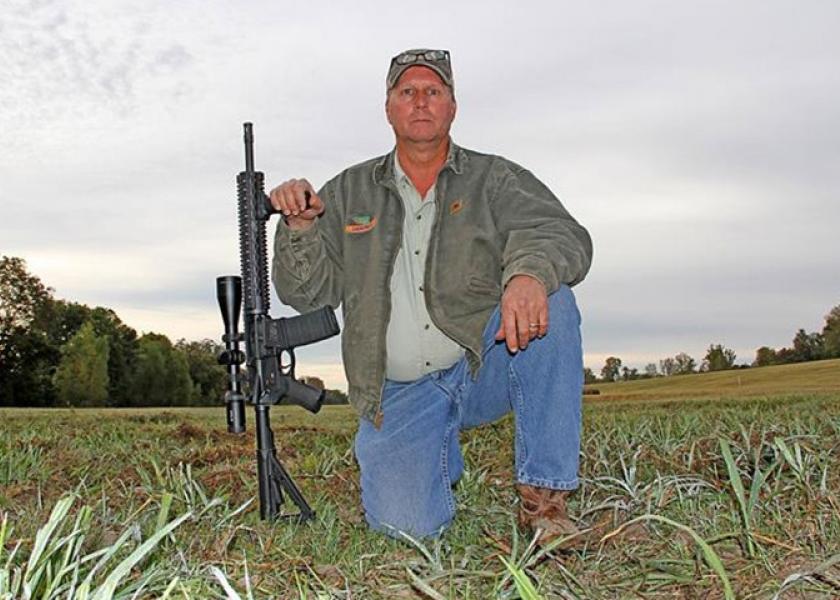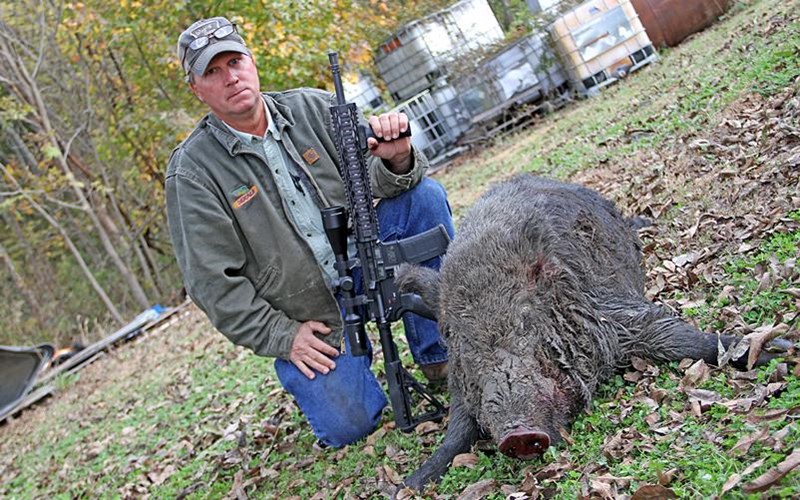March of the Wild Pigs

In the span of a single year, Michael Watts has killed over 400 wild pigs.
On a cool night in the Mississippi Delta, Watts is listening to an unmistakable crunching noise. A sounder of wild pigs is feeding in his pecan orchard and despite standing 60 yards downwind, Watts can clearly hear the shells cracking as the pigs gorge. He moves toward the din and when the sounder comes into view, counts over 25 pigs feasting on his crop.
Swinging a M4 .223 rifle from his shoulder – loaded with a 30-round clip -- Watts eases up a few more paces, settling behind a tree just 30 yards away. In his wide open corn fields, he never gets within 30 yards of pigs; the risk of trampling is too high, but his 200 acres of pecan trees afford a buffer at close-range. Peering down a thermal imaging scope, Watts places the crosshairs just behind the ear of a 200-lb. sow and squeezes the trigger. She crumples to the ground – and the melee begins. The pigs scramble for cover and as they flee, Watts drops four more with body shots. Five more dead pigs for Watts’ ballooning tally – and yet he knows he’s barely denting the population.
Watts’ Rena Lara, Miss., farmland is particularly vulnerable to pig damage -- backed up against 7,500 acres of Conservation Reserve Program (CRP) land behind the Mississippi River levee. Pared down, the wild pigs pour out of the heavily wooded CRP at night and use Watts' farmland as a food source. Since 2005, Watts has watched as the pig presence has grown on his operation. “Only a few years ago I killed the first hog on my farm, yet now I’m around 400 from October 2013 to October 2014,” says Watts. “This has been the worst hog year as far as damage to my farm. Let me be clear: I’m not even substantially damaging the population. Meanwhile, the surviving sows are having piglets at an unreal rate, and I’m not gaining ground, but I am spooking them away from my crops. They’ll eat anything. If they get corn, they’ll eat it. If they get a deer fawn, they’ll eat it.”
In 2012, wild pigs took out a 35-acre section on Watts’ corn ground. “At harvest, hogs had torn up my field so badly that I had to look 75 yards down the row to line up enough standing corn plants to know which way to run the combine.”
Wild pigs can be far worse on seed corn. It’s not unusual for pigs to get on a row at planting time and precision root the seed every 6”, eating every seed for 100 yards. “It’s pretty wild to see and I had a group clean out 10 acres of seed in one night. The hogs will root as straight down the row as the tractor ran. They may as well be following a GPS device.”
Pig bomb
Wild pigs are responsible for an estimated $1.5 billion in agricultural damage and control costs each year in the United States. However, Jack Mayer, manager, Environmental Sciences and Biotechnology Group, Savannah River National Laboratory, says the $1.5 billion does not include impacts like environmental damage, property damage, vehicle collisions, or water quality impacts. “The actual figure is probably up in the billions or even tens of billions of dollars. If we had a foreign animal disease outbreak -- African swine fever or classical swine fever – and that got into the wild pig populations and then into our livestock, that figure would likely get up into the hundreds of billions of dollars.”
They are established in 36 states and pop up sporadically in others. Cold weather is little detriment to pigs and they even thrive in the prairie states of Canada. Present U.S. population estimates place wild pig numbers at 6.3 million nationwide. Significantly, wild pigs numbered only 500,000 to 2 million in 1990. After 1990, the pig bomb exploded and the population began raging in North America.
“There’s no reason they won’t survive in all the lower 48 U.S. states,” says Mayer. “Those of us studying wild pigs in the 1970s and 1980s never saw this population explosion coming, but we should have seen the signs.”
What caused the pig bomb to detonate? Mayer, one of the foremost wild pig experts in the world, says after 1990, wild pigs became the second most popular big game animal in North America – right behind whitetail deer. “Essentially, hunters and hunting clubs often filled trailers with pigs down south, returned home, and turned them loose. It was completely illegal – breaking state and federal law, but that stopped few of these people. There was also an increase in commercial fence shooting operations offering ‘wild boar’ hunts. Virtually every state with these commercial fence shooting operations has experienced escapes.”
Wild pigs breed year-round and a wild sow produces two litters per year – six piglets on average, but litters can be as large as 12. Mayer says in captivity, sows can even produce three litters in a 14-month time period. Sows conceive as early as three months and boars are sexually mature at five months. “These animals can put more little feet on the ground than any other free-ranging mammal in North America their size or larger,” describes Mayer. With no effective predators, other than humans, wild pigs are permanently on the cusp of a population explosion.
Adult boars average 200 lbs. in size and sows are typically 170 lbs. Wild pigs are aptly labeled “opportunistic omnivores” that survive by eating anything – plant or animal. Agriculture crops – fruit, leaves or roots -- serve as a wild pig buffet, particularly in tandem with irrigation sources that most farms provide.
In a given crop area, there may be no wild pig activity until crops ripen, but directly afterwards, pigs appear almost on cue, due to an uncanny sense of smell. Mayer says pigs can detect odors emanating from up to seven miles away and 25’ below the surface.
Pig plague
Producer Chris Lively, Coahoma County, Miss., always thought wild pigs would never reach his farmland. “I had heard from several farming buddies about their hog problems to the south and I thought, ‘Well, they’ll never make it to my land.’ I was wrong.”
They bed down in woods adjoining Lively’s operation, eating his corn and trampling rice levees at night. “I shoot them on sight whenever I get a chance. There were 13 crossing my fields recently and I was able to kill seven. However, my main method of control is trapping with a cage. I’ve had better success with cage traps.”
Trapping has also worked well for producer Nelson Crow, Winchester, Ark. Crow’s pig problems began in 1999, and he attributes the initial explosion to misguided hunting practices.
The damage to Crow’s operation extends far beyond crop consumption. The sounders root up huge swathes of land and can leave acreage gutted with a strafe-bombed appearance. The damage to irrigation systems is incessant, particularly during the height of summer. “They love to hit soybeans while we’re irrigating. They’re not eating beans, but just cooling off in the wet mud. They tear up polypipe and do awful damage, but not when we’re pumping,” notes Crow. When pumps are off and polypipe lies flat, the pigs step on the plastic, punching perfectly shaped holes everywhere their dewclaws hit. “It costs me time and labor repairing polypipe – there’s never enough man hours to fix hog damage. When it’s a 300-lb. pig or more, they’ll step clean through the pipe, punching a hole through the top and bottom of the plastic.”
Crow hunts with night vision and suppressors, but is heavily dependent on traps. After trial-and-error, he has settled on two trap fencing designs: heart-shaped and figure six. The curvature and flow of each design help lure in entire sounders to the traps, which are baited with corn, creosote, and diesel. “The muddier and nastier the trap; the better it works. I’ve caught up to 30 pigs at one time.” Crow uses 4” by 4” goat panels for his trap fencing. Cattle panels allow piglets to escape through the holes and 34” hog panels can be cleared by agitated pigs.
“I talk with other farmers and I’ll try anything,” Crow explains. “During the day, we sometimes put corn in a buggy and go down the edge of the woods – along the turnrows -- and into a field, trying to suck them out of the trees where we can ease up and shoot them while they eat at night.”
Crow estimates he kills 100 pigs per year on his farm – just to keep up with control. “In my area, people actually brought in hogs to hunt and the population went wild and it’s only getting worse.” With Crow’s operation surrounded by heavy timber, he knows that cover, food and water will keep the pigs returning to his farm. “It doesn’t matter how many I kill; I know they’ll keep coming back. They always come back.”
Northern spread
Further north, Wildlife Management Coordinator Alan Leary, Missouri Department of Conservation (MDC), acknowledges the wild pig population is expanding. “This species is a genuine threat to wildlife, water quality, and natural resources. We work with individual landowners because feral pigs are also a big threat to domestic livestock and destroy agricultural fields. We get a lot of calls from landowners asking, ‘What can I do to stop feral pigs from destroying my property?’”
The MDC’s main control tactic is trapping with corn as bait, but Leary says the MDC also uses aerial gunning. Despite the growing threat, he believes the spread of wild pigs can be stopped in Missouri. “If agencies, NGOs, landowners, and others all work together -- we can push them back before the problem gets worse.”
Stemming the tide
Mayer has examined 20,000 wild pig specimens spanning 40 years of wild pig research experience. He was called in by National Geographic to examine the carcass of the legendary Hogzilla, a massive pig killed in 2004 in Georgia that attracted global attention. Hogzilla was purported to be over 12’ long and weigh over 1,000 lbs. “When we dug him up and examined the carcass, he was 8’ long and about 800 lbs. His tusks and skull were consistent with a pen-raised hog. The largest wild pigs will reach 500 lbs. and maybe a little bigger.”
Mayer places a question mark on the future of wild pig control. Due to prolific breeding, 50 percent to 75 percent of a pig population must be killed each year to keep population numbers in check -- a very difficult order for any state. According to Mayer, two options may hold promise: a pig-specific toxin and an oral contraceptive.
The pig-specific toxin is being researched and may be permitted in the near future. Will it work? “Some people are going to use it, but their neighbor right next door may not. Without uniform application, I’m not sure it would work,” says Mayer. “Hopefully people who wouldn’t be willing to use the toxin would be willing to use the oral contraceptive. Both are options, but both are surrounded with questions and would have to be used in a pig-specific feeder.”
At present, Mayer advocates a mix of controls: trapping, shooting, dogging, aerial gunning, and sometimes fencing. “When the pig bomb went off after 1990, we tried to warn people. Finally, wild pigs are being taken seriously, even at the federal level.”
Watts has a warning for other farmers. “I actually once thought I’d like having pigs around so I could have another hunting option – and that was my worst wish I’ve had. These animals are so bad that if I could, I’d kill every single wild pig in the country. It’s simple – they destroy everything. Everything.”









